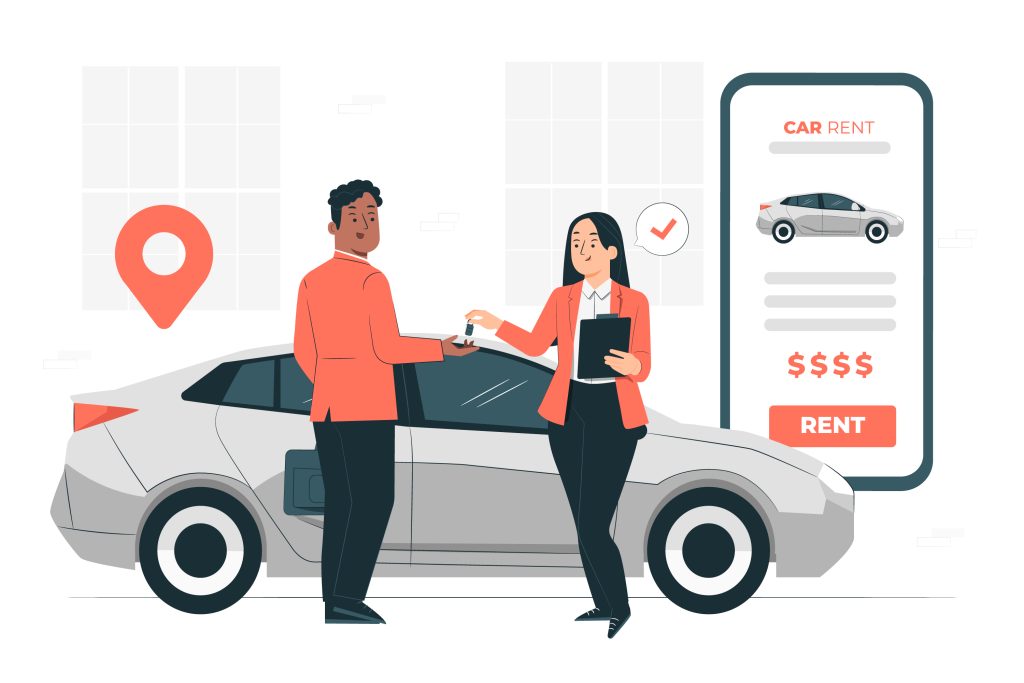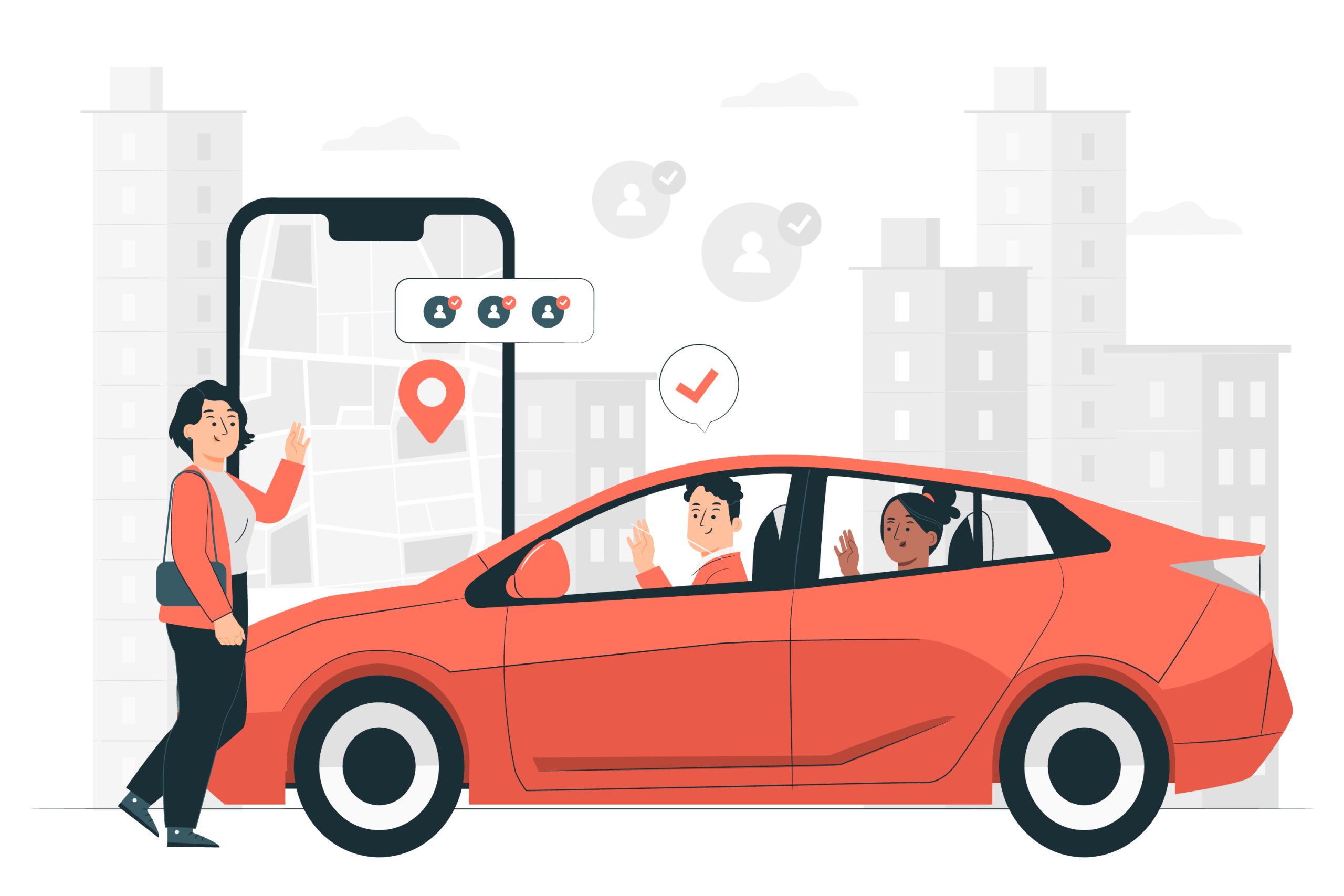Choosing between car rental and public transportation in London depends largely on personal preferences and the nature of the trip. For visitors who prioritize the economy and seek to experience the city like a local, public transport is undoubtedly the way to go. With its extensive network of buses, trains, and the Tube, coupled with cost-saving payment options like the Oyster card, public transport efficiently connects all major parts of the city.
For those traveling in groups or families, or for those needing the flexibility to visit off-the-beaten-path destinations, renting a car might be more practical. While it comes with higher costs and the challenge of navigating London’s busy roads, it offers the freedom to travel at one’s own pace and convenience. the choice should be guided by a balance of factors including cost, convenience, flexibility, and the kind of experience one wishes to have in the vibrant city of London.
Renting a Car in London: Expenses to Consider

1. Rental Fees
The type of vehicle you choose plays a significant role – opting for a luxury car will cost you more compared to a standard sedan or a compact car. Additionally, different rental agencies offer varying rates, often influenced by their service quality and additional benefits. On an average day, the cost of a standard car rental ranges from £30 to £100. This price variation gives you the flexibility to choose according to your budget and needs, whether it’s a budget-friendly hatchback for city travel or a more spacious SUV for a family trip.
2. Fuel Costs
The UK’s fuel prices are known for being on the higher side, significantly impacting your travel budget. Currently, the average cost of petrol hovers around £1.20 to £1.40 per liter. This price, however, can fluctuate due to various global economic factors. It’s crucial to consider this variable expense, as it can add up, especially if you plan on extensive travel outside the city. Opting for fuel-efficient vehicles or planning your route wisely can help mitigate these costs.
3. Congestion Charges
This fee, amounting to £15 daily, applies to most vehicles entering Central London from Monday to Friday. It’s a measure to reduce traffic congestion and encourage the use of public transport in the busiest parts of the city. If your travel plans include frequent trips to central areas during these times, the Congestion Charge can add a significant amount to your overall expenditure. It’s advisable to plan accordingly, possibly limiting the number of days you drive into these zones or using public transport on certain days to avoid these extra charges.
4. Parking Fees
Parking fees in central areas of the city, known for their high demand for spaces, can range from £3 to £8 per hour. This cost can quickly accumulate, especially if you plan to spend several hours at a destination. Public parking facilities and street parking options vary in price, with some offering discounted rates for evening or weekend parking. It’s advisable to research parking options and costs in advance, especially if you’re visiting popular tourist spots or business districts. Consider also the availability of hotel parking, which might offer a flat daily rate, though this can still be a significant addition to your travel budget.
5. Insurance
While it adds an extra £10 to £30 to your daily rental cost, it’s a necessary expense for peace of mind. Rental car insurance typically covers damage to the vehicle, theft, and liability for bodily injury and property damage to others. Some personal auto insurance policies or credit cards might offer coverage, but it’s essential to check their terms before declining the rental company’s insurance. Remember, opting for the rental company’s insurance means you’re fully covered according to their policy terms, which can save you from potential hefty expenses in case of an incident.
6. Insurance Excess
This is the amount you’re liable to pay in the event of an accident or damage to the vehicle. The excess fee is predetermined and can be quite substantial, depending on the rental company’s policy. Many renters choose to purchase an additional excess reduction policy to lower this liability. While this means an increase in your daily rental cost, it significantly reduces financial risk in case of an accident, making it a worthwhile consideration for peace of mind during your travels.
7. Additional Driver Fees
Car rental companies usually charge extra for each additional driver registered on the rental agreement. This fee compensates for the increased insurance risk and administrative costs involved. The charge can vary but is typically calculated on a per-day basis. While this increases the overall rental cost, sharing the driving responsibility can enhance travel flexibility and reduce fatigue during long journeys, making it a beneficial option for group travel or extended road trips.
8. GPS Rental
Renting a GPS device from your car rental company is an option, but it comes with an added daily cost. This charge can vary but generally adds a noticeable amount to your total rental expense. While it offers convenience, especially for those unfamiliar with London’s streets, considering alternative solutions like using smartphone GPS apps could be a cost-effective approach. Many travelers now opt for mobile apps that offer real-time traffic updates and turn-by-turn navigation, which can be just as efficient and more budget-friendly.
9. Child Safety Seats
In the UK, it is a legal requirement for children to use a child safety seat. Car rental companies offer these seats at an additional cost, which is indispensable for compliance with road safety laws. The price for renting child seats varies among companies but considering it an essential safety measure is important. For parents, this extra cost is a small price to pay for the safety and comfort of their children during their travels. It’s also advisable to check the availability and book these seats in advance, especially during peak travel seasons.
10. Late Return Charges
Car rental companies typically charge substantial fees for late returns. These charges can accumulate quickly, sometimes calculated on an hourly basis, and can unexpectedly inflate your rental costs. To avoid these fees, planning your travel schedule carefully is key. If you anticipate any delays, contacting the rental company as soon as possible is advisable. Some companies may offer a grace period or be willing to extend your rental for a lower fee than the standard late charge, but this is at their discretion. Being punctual or proactive in communication can save you from these unwelcome additional expenses.
Public Transport in London: An Overview of Costs

1. Oyster and Contactless Payment
These payment options provide a significant discount compared to the cost of individual paper tickets. An Oyster card, a smartcard that you can load with credit, is particularly advantageous for frequent travelers as it caps daily expenses, ensuring you never pay more than necessary. Contactless bank cards offer similar benefits, deducting the lowest fare for your journey automatically. Both methods are not just cost-effective but also add convenience, allowing you to swiftly tap in and out at tube stations, buses, and other forms of public transport without the hassle of purchasing separate tickets for each journey.
2. Travelcards
These cards allow for unlimited travel within chosen zones across London’s transport network, including buses, tubes, trams, and some rail services. You can purchase a Travelcard for various durations, from a single day up to a whole year, catering to both short-term visitors and long-term residents. A one-day Travelcard, for instance, is priced around £12.70, offering unrestricted travel within the zones it covers. This is especially cost-effective for tourists who plan to explore multiple areas of the city in a day, eliminating the need to buy multiple tickets and potentially saving a considerable amount of money.
3. Buses and Trams
Traveling by bus or tram in London is not only an efficient way to move around the city but also an economical one. Each single journey on a bus or tram costs a flat rate of £1.50, making it a straightforward and budget-friendly option for short trips. With this fare, you can undertake unlimited bus or tram journeys within an hour of first tapping your payment card, all for the price of a single journey. This feature is particularly beneficial for those who need to make multiple short trips in a row, as it offers the flexibility and freedom to hop on and off without incurring additional charges.
4. Tube and Rail Services
The London Underground (Tube) and rail services offer a vast network that covers a wide area of the city, making them popular choices for both locals and visitors. Fares on these services are variable and are based on the number of zones you travel through, as well as the time of day. Travel during peak times, typically weekday mornings and evenings, incurs higher fares due to increased demand. Understanding this fare structure is key to managing travel costs effectively. traveling outside of these peak times can lead to significant savings. Planning your travel schedule around off-peak hours, therefore, can be a strategic way to reduce expenses while still enjoying the extensive reach and convenience of London’s Tube and rail services.
5. Peak vs Off-Peak Fares
The cost of traveling on the Tube, DLR, and London Overground can vary significantly based on the time of your journey. During peak hours, which typically include weekday mornings and evenings, fares are higher due to increased demand. These are the times when most Londoners are commuting to and from work.
On the other hand, traveling during off-peak hours – which cover weekends, public holidays, and weekdays outside the rush hours – can lead to considerable savings. Being aware of these time slots and planning your travel accordingly can be a smart way to reduce expenses, especially for tourists and occasional travelers who have flexible schedules.
The most economical option for travel is the off-peak day Travelcard, valid after 9:30 am from Monday to Friday and throughout the weekend. This card covers zones 1-6 and is priced at £15.20, while the cost for peak times is £21.50. Additionally, if you opt for the Oyster Pay As You Go system, there’s a benefit of a price cap, ensuring that you never exceed the cost of a Travelcard. In many instances, you’ll find yourself paying less than the Travelcard price, making it a budget-friendly choice for navigating London.
6. Group Discounts
Exploring London as a group, be it with family or friends, can be made more cost-effective with group discounts offered on certain public transport options. These discounts are particularly advantageous for larger groups, as they reduce the individual cost of travel. Families traveling with children can also benefit from reduced fares for younger passengers. These group discounts not only make traveling together more affordable but also simplify the process, as everyone can move as a single unit without the need for multiple transactions. Whether it’s a day out exploring the city’s iconic landmarks or an excursion to the suburbs, availing of these group discounts can significantly lower the travel expenditure for group trips.
7. Visitor Oyster Card Special Offers
For tourists, the Visitor Oyster Card is not just a ticket to convenient and cost-effective travel across London’s public transport network; it also opens up a world of special offers and discounts. These offers range from reduced entry fees to popular attractions to discounts at select restaurants and shops across the city. By presenting a Visitor Oyster Card, tourists can enjoy a more enriched experience in London, potentially saving money on various aspects of their visit. This feature makes the Visitor Oyster Card a valuable tool for visitors, providing benefits that extend well beyond mere travel, helping to make the overall trip more enjoyable and budget-friendly.
Comparative Analysis of Renting a Car and Public Transport in London

1. Short-Term Visits
For tourists or individuals on brief visits, London’s public transport system presents a more economical choice. The ease of using Oyster cards, coupled with the expansive network of buses, trams, and trains, makes it a practical option. This network efficiently covers most areas of the city, reducing the need for expensive car rentals. Public transport in London is not only cost-effective but also allows visitors to experience the city like a local, and it often provides the quickest route to major tourist attractions. The system’s frequency and reliability make it a convenient choice, especially for those unfamiliar with London’s driving conditions and parking challenges.
2. Families and Groups
When it comes to traveling as a family or in a group, renting a car in London might be a more cost-effective solution, particularly for reaching destinations that are not easily accessible by public transport. The cost of multiple public transport tickets can accumulate quickly for a group, making car rental a competitive option. A rental car offers the convenience of traveling together, flexibility with schedules, and the ability to store luggage or travel essentials easily. It’s particularly advantageous for visiting attractions outside of central London, where public transport may be less frequent or more time-consuming.
3. Convenience vs. Cost
Renting a car in London offers a level of privacy and flexibility that public transport cannot match. It allows for spontaneous travel plans, direct routes to destinations without the need for transfers, and a personal space away from the crowds. This convenience comes at a higher cost, including rental fees, fuel, parking, and potential congestion charges. On the other hand, public transport, while being more affordable, might not always provide the same level of convenience, especially during off-peak hours or in areas less serviced by the network. Balancing the convenience of a private car against the cost savings of public transport is crucial, depending on the nature of the trip and personal preferences.
4. Environmental Impact
Choosing public transport over a rental car in London is a decision that significantly benefits the environment. The city’s commitment to reducing its carbon footprint is evident in its investment in low-emission buses and an electrically powered Underground system. By opting for these greener alternatives, travelers contribute to reducing pollution and traffic congestion, a critical concern in a major city like London. Public transport, with its efficient use of resources and space, is inherently more sustainable than private car travel. This environmentally conscious choice is particularly important in an era where reducing carbon emissions is crucial for global sustainability efforts.
5. Traffic and Congestion
London is dealing with its notorious traffic congestion, especially during peak hours. Navigating through busy streets in a rental car can be a daunting and time-consuming task, often leading to increased stress and lost time. In contrast, London’s public transport system, including trains and buses, operates on dedicated lanes and tracks, effectively bypassing much of the road congestion. This can result in a more efficient and relaxed travel experience, particularly during rush hours when traffic is at its worst. For those looking to avoid the hassle of traffic jams and the complexities of navigating a busy city, public transport emerges as the clear winner in terms of convenience and time-saving.
6. Flexibility and Routes
Renting a car in London offers the distinct advantage of flexibility, allowing travelers to set their schedule and routes, and reach remote areas not serviced by public transport. This freedom is especially appealing for those who wish to explore off-the-beaten-path locations or have specific destinations in mind that are outside the typical tourist circuit. This flexibility comes with its own set of challenges, such as finding parking and navigating unfamiliar roads. public transport in London’s central zones is often the quickest and most direct way to reach major attractions. The extensive network of buses, trains, and the Underground provides efficient and reliable connectivity across the city, making it a convenient option for those staying and traveling within the central areas.
7. Parking Availability
In the bustling heart of the city, parking spaces are at a premium, often requiring payment that can add up quickly. This issue can become a significant inconvenience for those renting a car, as they need to factor in both the time and cost associated with finding parking. Public transport, in contrast, bypasses this hassle entirely. Buses, trains, and the Underground can conveniently drop passengers near their destinations, sometimes even closer than a car might manage due to central London’s parking constraints. For those prioritizing ease and avoiding the stress of parking, public transport is a clear winner.
8. Cultural Experience
Riding alongside Londoners, visitors get a glimpse into the everyday lives of the city’s residents, adding a rich, authentic layer to their travel experience. It’s an opportunity to observe the diversity of life in London, potentially striking up conversations with locals or simply watching the daily hustle and bustle. This cultural immersion is hard to replicate in the isolation of a rental car, making public transport an appealing option for those seeking to experience the true flavor of London.
9. Accessibility
The city has put considerable effort into making its buses, trains, and Underground stations accessible to people with disabilities. Features like ramps, dedicated seating, and clear audio-visual announcements are commonplace, ensuring ease of use for everyone. In contrast, while rental cars with similar accessibility features are available, they often come with a higher price tag and the need to arrange these special accommodations in advance. For travelers with accessibility needs, public transport in London not only offers greater convenience but is often more cost-effective and readily available.
10. Night Travel
London’s public transport shines when it comes to night travel. The city’s extensive night bus network and the 24-hour operation of some Underground lines on weekends make it a reliable option for late-night journeys. This accessibility is particularly valuable for those exploring London’s nightlife or needing to travel after standard hours. navigating a rental car through London’s streets at night can be daunting, especially for those unfamiliar with the city. The challenges of nighttime driving, such as reduced visibility and driver fatigue, make public transport a safer and more convenient alternative for nocturnal travel.
Conclusion
In summing up the debate between opting for a rental car or navigating London via public transport, the decision rests on a spectrum of personal factors and trip specifics.
Public transportation emerges as a budget-friendly, environmentally conscious choice, particularly apt for individuals or tourists exploring central London. It offers a genuine slice of city life and an expansive network covering key areas.
Hiring a car provides unparalleled freedom and convenience, making it a preferred choice for families or groups, or for those venturing to less-trodden paths outside the city’s core. Each option carves out its distinct advantages, and the most fitting choice fluctuates based on the traveler’s bespoke needs and aspirations for their London adventure.
FAQs
In London, the daily rental cost for a car typically ranges between £30 and £100. This varies based on the vehicle’s model and the rental agency. Keep in mind that this price does not include additional expenses such as fuel, insurance, parking fees, and possible congestion charges.
Yes, when renting a car in London, consider additional costs like fuel, daily congestion charges (about £15 in central London), parking fees, and insurance costs. Additional expenses may include fees for extra drivers, GPS rental, child safety seats, and penalties for late returns.
Public transport in London usually offers a more budget-friendly alternative to car rental, particularly for short-term visitors. The use of Oyster or contactless cards makes fares cheaper than buying individual tickets, and Travelcards provide further savings. Public transport efficiently connects major areas and is an economical choice.
Yes, London’s public transport system caters to late-night travelers with its extensive network of night buses. Moreover, some Underground lines offer 24-hour service on weekends, ensuring accessibility and convenience during nocturnal hours.
For families, especially when visiting less accessible areas or carrying significant luggage, renting a car can be more practical and cost-effective. However, for travel primarily within the city, public transport is a more economical option, avoiding the hassles of parking and navigation.
Opting for public transport in London is a more environmentally responsible choice compared to car rental. The city’s commitment to reducing emissions is evident in its low-emission buses and electric Underground system. By choosing public transit, you contribute to lessening the environmental impact of your travels.



















